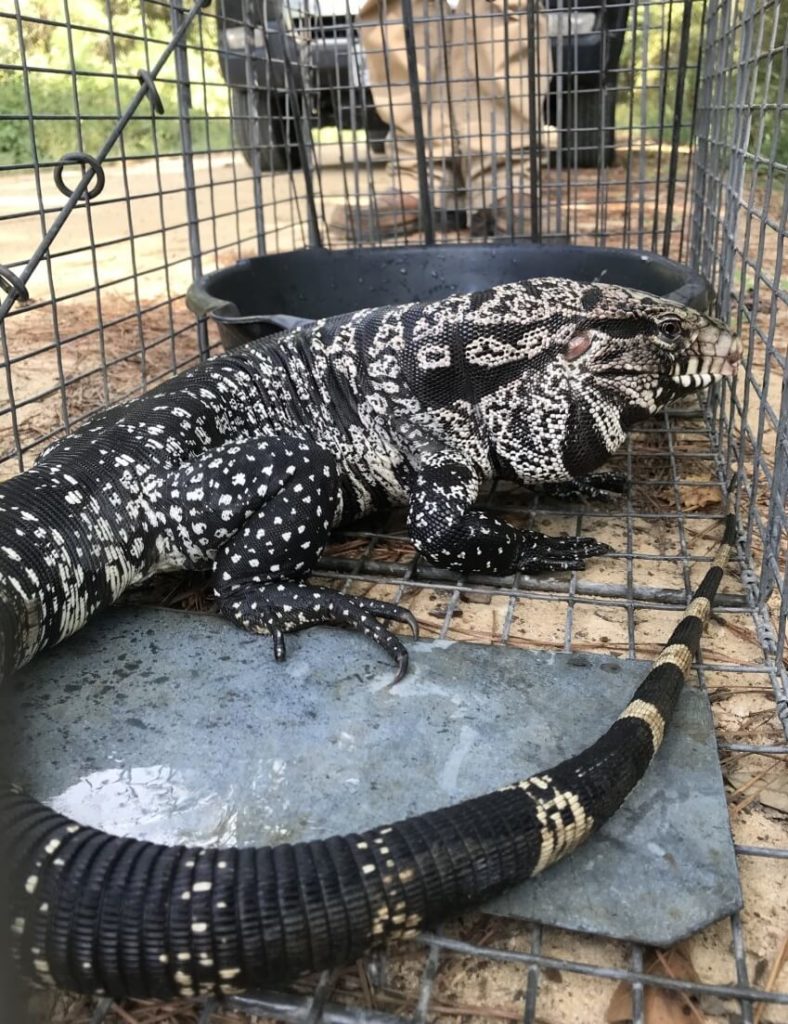By Rick Lavender for CAES News
Warming temperatures will have tegus on the move in southeast Georgia.
Residents and farmers are asked to report sightings of tegus, alive or dead. This is needed to keep the big, South American lizards from gaining a foothold in the state, according to the Georgia Department of Natural Resources (DNR). These reptiles, the largest of all tegu species, can reach 4 feet long and weigh more than 10 pounds.
Argentine black and white tegus are adaptable and hungry and pose a significant threat to native wildlife. Their appetite, which favors eggs (including those of protected species such as American alligators), can vary from pet food and plants to fruits, vegetables and small animals.

As a non-native species, tegus in the wild can be trapped or killed on private property with landowner permission and in accordance with animal cruelty and local ordinances. But DNR wants to know about all sightings to better gauge the invasive lizards’ spread.
The agency can provide loaner traps, advice and even help monitor for key sites, said Daniel Sollenberger, a DNR senior wildlife biologist.
“We are focusing our efforts to accomplish two goals: document the extent of where tegus occur in the wilds of southeast Georgia and remove those animals as soon as we can after they are detected,” Sollenberger explained. “With area residents, hunters and other folks helping us keep an eye out for and controlling tegus, we are cautiously optimistic we can control this population.”
While it’s not known where the tegus in Toombs and Tattnall originated — tegus are popular as pets — it’s clear they spell trouble in the wild. Sollenberger said that tegus are generalists in habitat, diet and the temperatures they can withstand. “They can live almost anywhere and eat almost anything.”
Studies by the U.S. Geological Survey suggest tegus could survive year-round in much of the Southern U.S.
There is also concern that tegus could spread exotic parasites to other wildlife and cause bacterial contamination of crops.
Once invasive species become established, they are almost impossible to eradicate. Florida is up to four wild tegu populations, and tegus have been reported in more than half of the state’s 67 counties. Trapping at one site along Everglades National Park can yield hundreds of tegus per season. Tegus also have been documented in the wild in South Carolina.
What can you do?
▪ Report tegus seen in the wild, alive or dead. Note the location, take a photo if possible and report the animal at gainvasives.org/tegus, (478) 994-1438 or gainvasives@dnr.ga.gov.
▪ In Toombs and Tattnall counties, keep pet food inside, fill holes that might serve as shelter and clear yards of debris such as brush piles that can provide cover for tegus.
▪ Be a responsible pet owner. Do your research before buying an exotic pet, and don’t let it loose.
▪ Note that as a non-native species, tegus in the wild in Georgia are not protected by state wildlife laws or regulations. They can be legally trapped or killed year-round. However, animal cruelty and local ordinances apply, as do appropriate safety precautions.
▪ Learn more about invasive tegus at georgiawildlife.com/tegus.










